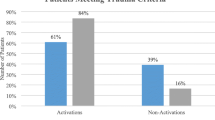Abstract
Purpose
Understanding the characteristics of trauma recidivists may allow trauma centers to tailor prevention programs. We hypothesized that there would be an increased incidence of violent injuries and falls in the urban vs. rural recidivists, respectively.
Methods
Trauma admissions from 2000 to 2011 were queried for incidences of recidivism. Age (<65 or ≥65 years), gender, Injury Severity Score (ISS, <9 or ≥9), mortality, and injury cause (fall, violence, or other) were analyzed with univariate analyses to test for differences between urban and rural patients. Significant variables were then included in a binary logistic model and further stratified based on environment.
Results
There were a total of 19,600 trauma admissions from 2000 to 2011, representing 18,711 unique patients, with 1,690 admissions (8.6 %) attributed to 801 recidivists (4.3 %). The overall percentages of recidivist trauma admissions attributed to urban and rural patients were 8.6 and 6.9 %, respectively (p < 0.001). When adjusting for age ≥65 years as well as falls and violent injuries, patients from urban environments were at 1.12 times higher odds of being a recidivist than their rural counterparts [odds ratio (OR) 1.12; 95 % confidence interval (CI) 1.01–1.25; p = 0.039]. When stratified into rural and urban groups, falls and violent injuries were significant in both groups of recidivist admissions; however, age ≥65 years was only significant in rural recidivist admissions.
Conclusion
An urban trauma admission had 12 % higher odds of being attributed to a recidivist than its rural counterpart, when controlling for age and mechanism of injury (MOI). Age ≥65 years was a significant variable in rural but not urban recidivist admissions. Characterizing the recidivist may allow for targeted prevention and intervention programs to decrease repeat hospital visits.

Similar content being viewed by others
References
Reiner DS, Pastena JA, Swan KG, Lindenthal JJ, Tischler CD. Trauma recidivism. Am Surg. 1990;56(9):556–60.
Poole GV, Griswold JA, Thaggard VK, Rhodes RS. Trauma is a recurrent disease. Surgery. 1993;113(6):608–11.
Wan JJ, Morabito DJ, Khaw L, Knudson MM, Dicker RA. Mental illness as an independent risk factor for unintentional injury and injury recidivism. J Trauma. 2006;61(6):1299–304.
Smith RS, Fry WR, Morabito DJ, Organ CH Jr. Recidivism in an urban trauma center. Arch Surg. 1992;127(6):668–70.
Williams JM, Furbee PM, Hungerford DW, Prescott JE. Injury recidivism in a rural ED. Ann Emerg Med. 1997;30(2):176–80.
Buss TF, Abdu R. Repeat victims of violence in an urban trauma center. Violence Vict. 1995;10(3):183–94.
Hedges BE, Dimsdale JE, Hoyt DB, Berry C, Leitz K. Characteristics of repeat trauma patients, San Diego County. Am J Public Health. 1995;85(7):1008–10.
Cooper C, Eslinger D, Nash D, al-Zawahri J, Stolley P. Repeat victims of violence: report of a large concurrent case–control study. Arch Surg. 2000;135(7):837–43.
Caufeild J, Singhal A, Moulton R, Brenneman F, Redelmeier D, Baker AJ. Trauma recidivism in a large urban Canadian population. J Trauma. 2004;57(4):872–6.
Brooke BS, Efron DT, Chang DC, Haut ER, Cornwell EE 3rd. Patterns and outcomes among penetrating trauma recidivists: it only gets worse. J Trauma. 2006;61(1):16–20.
Sayfan J, Berlin Y. Previous trauma as a risk factor for recurrent trauma in rural Northern Israel. J Trauma. 1997;43(1):123–5.
Kaufmann CR, Branas CC, Brawley ML. A population-based study of trauma recidivism. J Trauma. 1998;45(2):325–32.
Toschlog EA, Sagraves SG, Bard MR, Schenarts PJ, Goettler CC, Newell MA, Rotondo MF. Rural trauma recidivism: a different disease. Arch Surg. 2007;142(1):77–81.
Gubler KD, Maier RV, Davis R, Koepsell T, Soderberg R, Rivara FP. Trauma recidivism in the elderly. J Trauma. 1996;41(6):952–6.
Topologically Integrated Geographic Encoding and Referencing (TIGER). US Census 2010. http://www.census.gov/geo/maps-data/data/tiger.html. Accessed June 2012.
Scott KK, Tepas JJ 3rd, Frykberg E, Taylor PM, Plotkin AJ. Turning point: rethinking violence–evaluation of program efficacy in reducing adolescent violent crime recidivism. J Trauma. 2002;53(1):21–7.
Gomez G, Simons C, St John W, Creasser D, Hackworth J, Gupta P, Joy T, Kemp H. Project Prescription for Hope (RxH): trauma surgeons and community aligned to reduce injury recidivism caused by violence. Am Surg. 2012;78(9):1000–4.
Conflict of interest
A. Rogers, M. Horst, K. Rittenhouse, T. To, S. Gibson, C. W. Schwab and F. Rogers declare that they have neither conflict of interest nor sources of funding to disclose.
Compliance with Ethics Guidelines
This article does not contain any studies with human or animal subjects performed by the any of the authors.
Author information
Authors and Affiliations
Corresponding author
Rights and permissions
About this article
Cite this article
Rogers, A., Horst, M., Rittenhouse, K. et al. Urban versus rural trauma recidivism: is there a difference?. Eur J Trauma Emerg Surg 40, 701–706 (2014). https://doi.org/10.1007/s00068-013-0355-6
Received:
Accepted:
Published:
Issue Date:
DOI: https://doi.org/10.1007/s00068-013-0355-6




